— Partnering to tell stories about the end of life
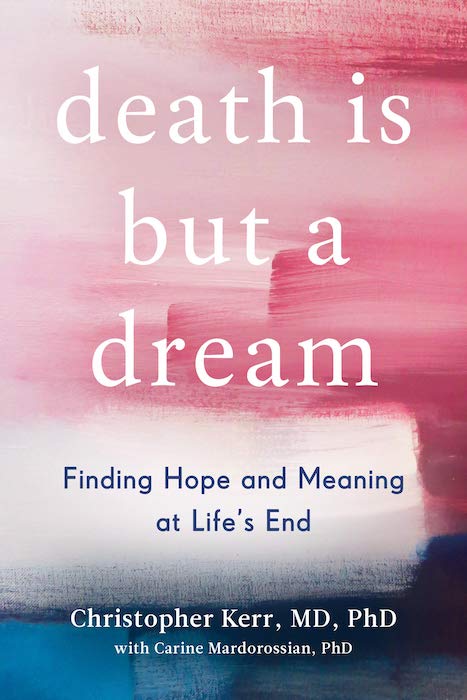
UB professor Carine Mardorossian has worked with hospice doctor Christopher Kerr on projects that explore end-of-life experiences from the perspective of both patients and caregivers
On April 15, the WORLD Channel, carried by public television stations across the U.S., will air “Death Is But A Dream,” a documentary based on a book co-authored by local hospice doctor Christopher Kerr and University at Buffalo Professor Carine Mardorossian.
The book, “Death Is But a Dream: Finding Hope and Meaning at Life’s End,” is the brainchild of Kerr, who over the course of his career noticed a pattern in patients who were near life’s end. He observed that in end-of-life stages, many people began to have dreams and visions of deceased loved ones visiting them at bedside. The dreams and visions often became more frequent as death drew near.
After researching and collecting data for over a decade, Kerr wanted to write a book which archived and told the experiences his patients were having.
The lengthy process of getting the book to where it is now, being published in 10 different languages and sold in 10 different countries, was rough at first. The timeline of how Kerr and Mardorossian came together in writing the book was “quite interesting,” says Kerr, MD, PhD, chief medical officer and CEO for Hospice & Palliative Care Buffalo.
When Kerr and his literary agent began the process, they originally sought out a different author to assist in putting Kerr’s research into meaningful words. The partnership quickly collapsed because Kerr believed that to write about subject, you would have to witness the patients’ experiences in person, which at that time, the prospective writer was unable to do.
Mardorossian, on the other hand, had been friends with Kerr for over a decade as she stabled her horse at Kerr’s barn. In passing, Kerr explained to her that he had given up on the book because finding a writer who saw eye-to-eye with him was hard to accomplish.
Mardorossian, PhD, a professor of English and of Global Gender and Sexuality Studies in the UB College of Arts and Sciences, offered her services. But as an academic writer, her style of writing was not what Kerr was looking for — initially.
“I continually said to Kerr, ‘Let me write it,’” says Mardorossian. “I’m not that type of person, I’m really not. I honestly felt like I was having an out-of-body experience, as I caught myself insisting: I had never written a book for the mainstream, yet I was so determined to write this one.”
Kerr ultimately decided Mardorossian was the right fit, and he again pursued the book. The process of writing soon began and took the duo a year and a half to complete. Kerr says Mardorossian “helped me find a much deeper meaning.”
“I talked to Christopher every single day, and we met up to five times a week, and we would work,” says Mardorossian. “It was a constant back and forth.”
Kerr added, “We took over coffee shops that they should have expelled us from. We could have opened and closed some of them.”
The partnership flourished. The book got picked up by Penguin Random House after what Mardorossian said was “a longer than usual bidding war” between seven companies.
Looking back, Kerr said that there was never an argument or tension throughout the whole process, as their egos were left behind. Kerr admires Mardorossian’s work ethic and determination, and calls the experience of working with her “the most enjoyable process.”
Mardorossian discusses the importance of Kerr’s work in, “As death approaches, our dreams offer comfort, reconciliation,” an article published in The Conversation.
“As hospitals and nursing homes continue to remain closed to visitors because of the coronavirus pandemic, it may help to know that the dying rarely speak of being alone. They speak of being loved and put back together,” Mardorossian writes. “There is no substitute for being able to hold our loved ones in their last moments, but there may be solace in knowing that they were being held.”
Mardorossian and Kerr are now writing another book which will be a “natural extension” from their first one, says Mardorossian. The new project will be from the caregiver’s perspective.
Kerr and Mardorossian want to shed light on these caregivers’ experiences because they believe the grieving process is an important part of someone’s end-of-life experience.
“Family members have to become nurses whether they know anything about nursing or not,” says Mardorossian. “The testimonies Kerr has collected from these caregivers say how it’s the hardest thing they’ve ever done, but also the best thing as well.”
Complete Article ↪HERE↩!
The struggle for the right to choose when and how to die
Katie Engelhart’s book spells out the moral and practical conundrums
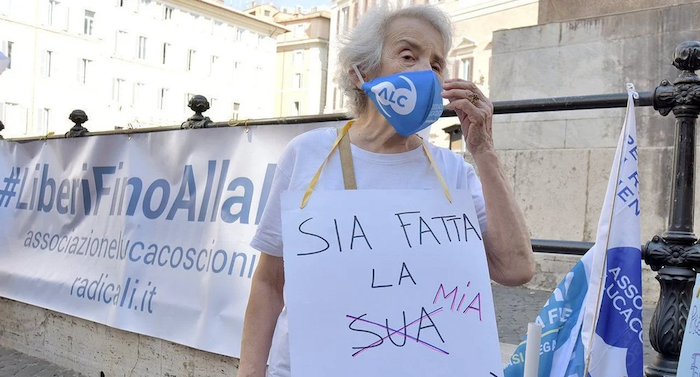
IF IT IS humane to put down a dog in unbearable and incurable pain, why not extend the same right to humans if they want it? That question echoes through “The Inevitable” as it follows four people in search of a good death—and in fear of a bad one.
Katie Engelhart’s deeply researched and beautifully reported book raises familiar quandaries. Do people have a right to die on their own terms? Should doctors help? Do motivations matter? And might a right become a duty for everyone who grows old, dependent or demented? It also considers less publicised problems, such as: how do people actually die? Advances in medicine and technology that have made pills and appliances safer have made it harder to achieve an “easy” or “peaceful” death for those who seek one.
As policymakers and ethicists ponder these moral conundrums, around the world people are taking matters into their own hands, a trend that gives Ms Engelhart’s book its urgency. Faced with intolerable suffering, her subjects have largely given up on laws and doctors and instead turn to strangers on the internet for help. For instance, Avril Henry, a British octogenarian, spent her nights “marinating in her pain” and considered eating lethal fungi from her garden to end it. But “death by mushroom could be slow, messy, painful. The Nembutal would work better.” The “Peaceful Pill Handbook”suggested buying that drug from either a vet-supply store in Mexico or the Chinese black market. Doubtful about Chinese merchandise, Henry settled on Mexico.
Over several years, Ms Engelhart’s main characters meticulously plan their escapes from old age, dementia and chronic or mental illness. She also follows two doctors, one of whom lost his licence for teaching people how to “exit” via “DIY death seminars”. At times the book itself has a DIY air, taking in the practicalities of connecting a gas canister to a plastic bag that can be placed over a head.
The similarity between the “euthanasia underground” that it describes and underground abortion networks is striking. The president of Compassion & Choices, a lobby group for doctor-assisted dying, once referred to plastic-bag hoods as “the end-of-life equivalent of the coat hanger”. Among those to have taken charge of their deaths were some early AIDS patients, their suffering immense, their fates fixed. Just having the right drugs, or knowing they could get them, seemed to make many of these young men feel better, recalls the more likeable of the two doctors.
Henry planned to kill herself with the Mexican drugs in her bathtub, but fretted that she would soil herself and that her house would smell. Dignity—in life and death—seems to preoccupy her and others above all. Even more than a bad death they fear a bad end to life, in which they are no longer themselves. A desire for autonomy runs through their stories like the thin veins of some of the characters.
Yet this is not a right-to-die manifesto. The author’s own ethical doubts are among the book’s strengths. She writes compassionately of her subjects’ struggles, but is more reserved about the motives of some of their helpers. She remains torn about what is perhaps the hardest question of all: euthanasia for victims of dementia. Rather than passing judgment, she presents facts. About half of Americans think patients do not have enough control over end-of-life decisions. Existing laws often have arbitrary effects.
After the drugs arrived from Mexico, Henry’s house was raided by police. She had discovered the concept of the “Completed Life”. “That’s when you feel that your life is shaped and finished. And the direction thereafter is down. I did have a complete life. It was a great life,” she told a friend. Soon after the raid she was found in her bathtub, having drunk the poison the police had missed. The note she left had a postscript: “If I have fouled the bath in death, please please be kind to wash it down.” She provided the disinfectant.
Complete Article ↪HERE↩!
‘Dear Life’ explores the beauty of end-of-life experiences
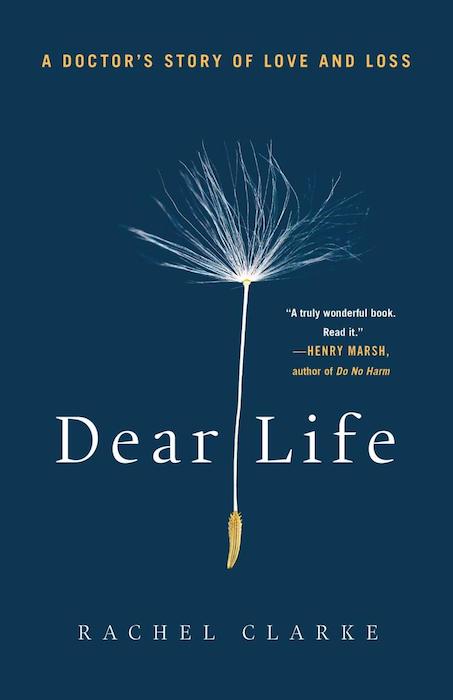
Before the doctor opened her mouth, you knew this wasn’t going to be good.
And it wasn’t, although you can barely remember what happened a minute after you heard the diagnosis. All you could wrap your head around were monitors and tubes and machines and death, when what you needed was “Dear Life” by Rachel Clarke, and a reminder that it wasn’t time for that yet.
When she was a little girl, Rachel Clarke was in awe of her father, a doctor who loved music and nature and who shared his sense of curiosity with his children. As a teen, Clarke toyed with the idea of following in his footsteps, but she chose a career in television instead. And then one day, after experiencing a couple of close brushes with death, she decided to go back to school to become a doctor, specializing in palliative medicine.
“I learned that dying, up close, is not what you imagine,” she says. “It is the essence of living… that really matters…”
About death, there are two main things: unlike our ancestors, we aren’t used to it; and we can’t know what it’ll be like. These are what Clarke helps her patients and their families deal with, and while she can’t answer the latter question, she promises them that the days and hours before the end are as full of life as possible.
Sometimes, that means meeting fears head-on, and discussing death matter-of-factly. Sometimes, it’s asking questions of a patient because no one else has done so. Caring for someone who’s dying may mean literally opening a window to sunshine or birdsong, holding a hand, letting “a wife curl up in a hospital bed beside her dying husband,” or encouraging a visit from a pet or a beloved grandchild. And sometimes, a doctor just needs to remember that “There is always a spark of beauty or significance…in the life you have left,” even when the person dying is someone the doctor loves.
This year, no doubt, you’ve seen enough death to last several lifetimes, and you’re not sure you can withstand a book about it right now.
But hold on, because “Dear Life” lives up to its title.
Beautiful, thoughtful, and loving, this book is absolutely brimming with life as author Rachel Clarke describes the end-of-life care offered at the hospice where she works and some of the most memorable patients to whom she ministered care.
If that sounds like an anti-life book, well, it’s not. It’s true that people die in this book, and they do it often but Clarke’s accounts of their days prior to death are quiet and serene, with no fear, no pain, and the minimum of loose ends left. Her workplace is not a sterile, clinical home where people go to die; rather, it’s a place where people die but first, happiness sneaks in sometimes.
And for that, curiously, this book on death-and-life may be the balm your COVID-bruised mind needs now. Indeed, calm, truthful, and not too gory, “Dear Life” is good.
Another book to look for is “Grief: The Biography of a Holocaust Photograph” by David Shneer. It’s the story of a photo taken toward the end of World War II, and the emotion inside it. Part meditation, part history, this book is perfect for the historian, too.
Complete Article ↪HERE↩!
What to read when you’re grieving a loved one

By Yvonne Abraham
I am a great grief compartmentalizer. I can put sadness into a box or write about it, pretending to be a detached expert. My therapist tells me I don’t feel it, though. She claims I have one button for all emotions, and that by turning off the grief, I also prevent myself from experiencing joy, hope, and excitement. You can’t get the good without the bad, she claims. I hate that.
There are a zillion wonderful books about loss, but none of them helped me feel. But a script did it. It unstuck the button. “Fleabag: The Scriptures,” Phoebe Waller-Bridge’s compilation of scripts from the show, includes pages of dialogue showing her character’s compartmentalized grief, which was all too familiar. On page 331, in a flashback, Fleabag considers the loss of her mother, and tells her best friend, ”I don’t know what to do with it —” “With what?” the friend, Boo, asks. “With all the love I have for her. I don’t know … where to — put it now.” Reading that, I was able to see all the love for my late mom that has been following me for years, with nowhere to go. I’m learning to give it to others. “I’ll take it,” Boo offers Fleabag. “No, I’m serious. It sounds lovely.”
MEREDITH GOLDSTEIN
Letters for life
The opening words of Donald Hall’s “Letter After a Year,” addressed to his late wife and fellow poet Jane Kenyon, are: “Here’s a story I never told you.”
Hall proceeds to describe a time, long before he met Kenyon, when he discovered letters in the attic of a rented house that a previous tenant had written to a lover who had died in a plane crash. He recalls his puzzlement back then: “She’s writing to somebody dead?”
But Hall came to understand, and act on, that same impulse after Kenyon died at 47. The proof of that is “Without,” a 1998 collection of poems (many of them with the word “Letter’’ in the title) that falls somewhere between conversation and correspondence. These poems are written about and to Kenyon, who succumbed to leukemia in 1995 on the New Hampshire farm where she and Hall lived.
Now, it would be a mistake to read “Without’’ in the expectation of bromidic uplift. Hall was too honest a poet — and too faithful a husband — for that. There is overwhelming pain in these pages, numerous times when, in Hall’s words, “grief’s repeated particles suffuse the air.” In “Letter in the New Year,” Hall writes to Kenyon that “this new year is offensive because it will not contain you.” For him, grieving is not a linear process but a flailing struggle to stay afloat amid a flood.
Yet within the quasi-epistolary structure of “Without” can be discerned the hope that, on some indefinable level, a relationship is not over so long as one partner lives. Hall updates Kenyon on the doings of children, grandchildren, and friends; he tells her about watching the Red Sox; he describes the springtime arrival of goldfinches and the emergence of daffodils on the hillside. And he evokes the numberless little moments that made up their life together, from shopping to lovemaking to holiday rituals like Kenyon’s habit of opening the daily Advent calendar window and then reading the Gospels. “Ordinary days were best, when we worked over poems in our separate rooms,” Hall tells Kenyon.
To be “without,” obviously, is a fate that befalls many of us. What Hall’s poems suggest is that memory, and perhaps an untold story or two, can help sustain just enough “with” to pull us through.
DON AUCOIN
Walking with grief
Grief of any kind obeys a logic all its own. But a parent’s grief over the loss of a child must defy logic altogether. “Because how can one articulate logical, coherent, human speech when the foundations of logic and proper order, the so-called natural order, the order whereby parents should not mourn their children — have foundered?”
So writes the Israeli author David Grossman, who lost his own son in Israel’s Second Lebanon War in 2006. Some five years after that shattering event, Grossman, in keeping with this observation, corralled the materials of his own mourning not into a coolly coherent memoir but into a kind of haunting parable.
A grieving man gets up from dinner one night and sets out to walk around his village in ever-widening circles. He has left behind normal life to search for his departed son, to seek out an elusive place described only as “there,” to trace on the land his own spiraling itinerary of loss and boundless yearning. The man begins his walk alone but is quickly joined by others who have also lost children, each one inevitably trapped within a kind of private exile yet now, suddenly, walking together.
Narrated in spare, poetic language, “Falling Out of Time” is a story of reckoning and reclamation — of learning to live with, and without, the dead. The novel, which was recently adapted by composer Osvaldo Golijov into a tone poem of the same name, also constitutes its own act of co-walking with the grieving, a way of broadening outward from sharp solitude of private sorrow. Finally, it is a meditation on the working through of a wild, impossible grief until the point that, as Grossman writes, “there is breath inside the pain.”
JEREMY EICHLER
Keep moving forward
“It’s okay. She’s a pretty cool customer.”
That’s what a social worker says to a doctor who’s wondering how to tell Joan Didion that the heart attack suffered barely an hour ago by her husband, the novelist John Gregory Dunne, had proven fatal.
Anyone who knows the chill, clipped control found in Didion’s novels and essays realizes how well “cool customer” describes her as a writer. How it does and doesn’t apply to her as a grieving widow is the burden of “The Year of Magical Thinking.” It won the 2005 National Book Award for Nonfiction, but to think of so searching and personal a work in terms of something as transitory as a literary prize doesn’t so much miss the point as ignore it.
The point is that neither grief nor life stops. It’s not just the consequences of Dunne’s death that Didion writes about but also dire health crises affecting their daughter, Quintana, over the same period of time. To lose one’s spouse and then possibly one’s only child? The Old Testament may offer the closest literary counterpart: the Book of Job. That “Magical Thinking” and its author merit the comparison is no small compliment to Didion as writer and human being both.
MARK FEENEY
Complete Article ↪HERE↩!
Why Arun Shourie concludes that the ultimate preparation for death is simply love
The former Union minister and veteran journalist’s latest book, ‘Preparing for Death’, is both a contemplation of and an anthology on death
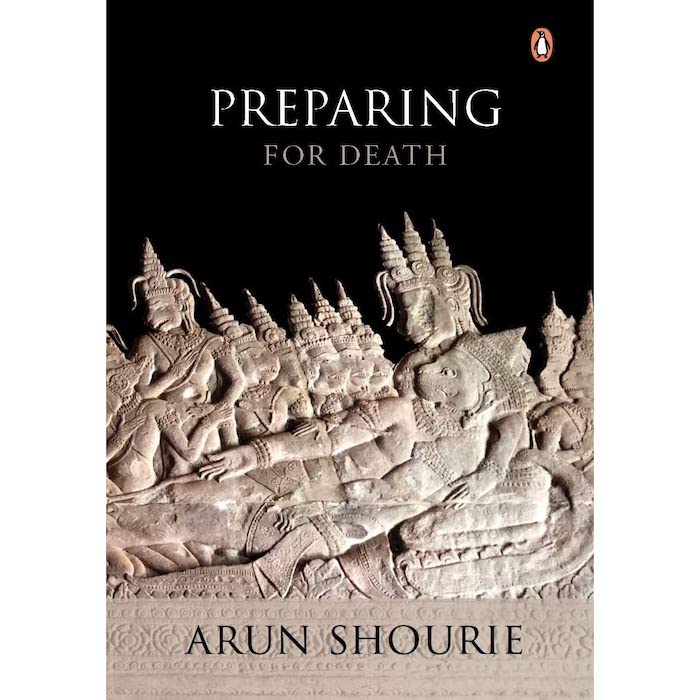
Arun Shourie is an unflinching seeker. He has an exemplary ability to face the toughest questions. After a bracing meditation on the problem of suffering in Does He Know a Mother’s Heart (2011), Shourie now turns to Preparing for Death. There used to be a joke that the purpose of literature is to prepare you for the good life, while the purpose of philosophy is to prepare you for the good death. But it is hard to understand our own extinction. Broadly speaking, two diametrically opposite views are invoked to reconcile us to death. One is that we don’t really die; in some form, through an incorporeal soul or something, we continue to exist. The other unflinchingly accepts that we just are evanescent matter and nothing else. Both approaches address the question of dying by simply saying “there is nothing to it.” There is something to this strategy, but it cannot make sense of the significance of life. It seems we can either make sense of life or of death, but not of both.
Shourie’s book takes a brilliantly different pathway. The book has three distinct themes. The first, the most powerful and meditative section of the book is not so much about death as the process of dying. He documents with detail, “great souls” experiencing the often painful dissolution of their own body — the Buddha, Ramkrishna Paramhansa, Ramana Maharshi, Mahatma Gandhi, and Vinoba Bhave, and, as a cameo, Kasturba. All of them give lie to Sigmund Freud’s dictum that no one can contemplate their own death. But what emerges from these accounts is not so much the conclusion that they all faced death unflinchingly; most of them have a premonition. It is also not about capturing the moment where the good death is leaving the world calmly. It is rather what the suffering body does to consciousness, all the memories and hard decisions it forces on us.
But the relationship between the body and consciousness goes in two different directions at once. On the one hand this suffering is productive: consciousness works through this pain. On the other hand, even the most exalted soul does not escape the utter abjection of the body. The most poignant moment in this section is not the calm and plenitude with which these exalted souls face death; it is the moments where even the most powerful souls are reduced to abjection by the constraints of the body. The only one rare occasion where Ramana Maharshi ever loses his cool is in his now utter dependence on others for most basic bodily functions. The problem of dying is not that you cannot ignore the body; it is that the body does not ignore you.
The second theme of the book is to take a sharp scalpel to false comforters of all religions and philosophies that promise the everlasting soul, or the preservation of bodies only to subject them to torment in hell. This metaphysical baggage makes dealing with death harder and is a total distraction. This section is less generous in its interpretive sympathies. The third theme of the book, interspersed in various parts, is about the discipline of dealing with your own body as it is in the process of dying. The book impressively marshals a variety of sources, from the Tibetan Book of the Dead, with its incredible imaginative exercises that make you take in the whole of existence, to Jain sources of Sallekhana, and various meditative techniques to inculcate a certain kind of mindfulness. But mostly one gets the sense that the ultimate preparation for death is simply love, something that can endow the evanescent moment with significance.
But this is a seeker’s book. It is in parts profound probing, honest but not dogmatic. Its immense value comes from the fact that the book is both a book and an anthology on death, with extracts from not just the words of those experiencing the process of dying, but an astonishing range of sources: from Fernando Pessoa to Michel de Montaigne, from yoga to the Tibetan Book of the Dead. For the politically inclined, there is an ambivalently revealing account of the Prime Minister’s visit to Shourie while he was in the ICU. All throughout, the book is laced with judiciously selected poetry: the startling moment where Gandhi recites the Urdu couplet to Manu: Hai baha- e-bagh-e duniya chand roz/ Dekh lo iska tamasha chand roz, a register you might associate more with Guru Dutt than Gandhi. There is a lot of Kabir, of Basho poetry and haikus. One stunning one: Circling higher and higher/At last the hawk pulls its shadow/From the world.
This haiku caught my attention because I happened to be reading a stunning essay by Arindam Chakrabarti at the same time, “Dream, Death and Death Within A Dream”, in Imaginations of Death and the Beyond in India and Europe (2018), a volume edited by Sudhir Kakar and Gunter Blamberger, that reads as a great philosophical complement to this one. That volume has a powerful piece by another brilliant philosopher, Jonardan Ganeri, on illusions of immortality that deals with a source Shourie cites at length: Pessoa. Chakrabarti’s essay ends with the insight of Yoga Vashishtha: To be born is to have been dead once and to be due to die again. Shourie is perhaps right: Can we really unravel what it means for the hawk to pull its shadow from the world? Does the shadow reappear if it flies lower?
Complete Article ↪HERE↩!
We all need to debate death and dying, and consider our own deaths
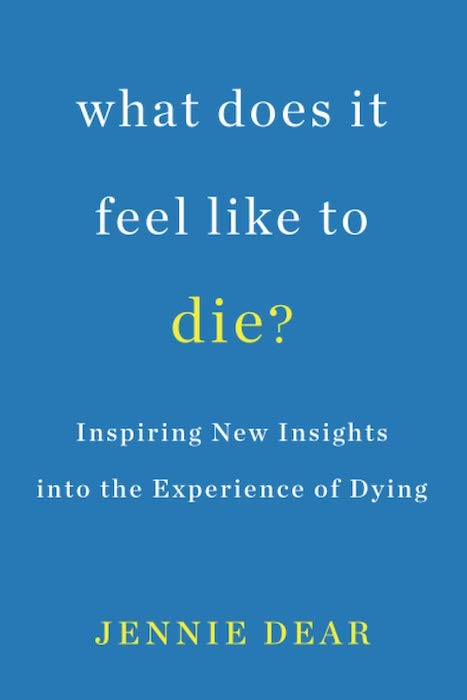
By Arnoldo Kraus
“Everyone’s death is different,” writes Jennie Dear at the end of her book, What Does it Feel Like to Die? Inspiring New Insights into the Experience of Dying. Dear is correct: just as every life is different, so every death is different. The dissimilarities in deaths lie in whether or not we accept the inevitability of death and especially in our internal dialogues about the necessity of death. Dear’s book tries to answer an old problem: how to speak openly and freely about the different ways of dying? The power of modern medicine makes these discussions particularly urgent—to preserve autonomy and avoid harm at the end of life. What does it Feel Like to Die? is an open invitation to talk about the limits of life as well as of the limits of medical technology.
Real life experiences are “the best teacher.” In Dear’s book readers learn how her family members and friends confronted the existential crisis that comes with dying. The book is directed to readers eager to understand the meaning of facing our mortality, the significance of dying, people’s deep denial about what is happening, and the ways to cope with dying. She uses many ways to answer the difficult question: What does it feel like to die? In richer societies, modern death is sometimes a kind of disease as instead of prolonging life, medicine prolongs death.
Dear discusses how in rich societies assisted suicide and euthanasia were until recently largely taboo. The major impression of the West of the Buddhist monks expelled from Tibet after the invasion by China was the almost absolute negation of death. In many Eastern cultures knowledge of self precedes knowledge of the world. The order is clear: first the inside, then the outside. In the West the order (or disorder) is upside down: first the exterior, occasionally the interior. When people do not reflect on themselves, and the purpose of living is seen in material achievements, it is difficult to accept and understand the dying process.
What Does it feel Like to Die? is not a medical book and is not directed at health professionals, but an increasing number of health professionals are themselves unfamiliar and uncomfortable with death. It is a vivid book about the process of dying by a daughter, a former journalist, and long-time hospice volunteer. The triad of daughter, journalist, and volunteer allows Dear to study the soul of very sick patients who will die in weeks or months despite the best attention from doctors and nurses. She understands the implications of end-stage disease, “a disease that cannot be cured or adequately treated that is reasonably expected to result in death of the patient.” She explains in plain language the feelings of dying patients: “dying is different for everyone. There’s no textbook”; “pain seems to dissipate in the very last few hours, and, for most people, those hours are peaceful”; “in the last two weeks of her life, my mother was ready and eager to die”; “I’ve also tried to convey some sense of the beauty and joy that often surround dying, the sense of meaning it can give to the dying person and people around her.”
Dear includes topics like the existential “slap”, where people die, whether dying hurts, and the last few hours of someone’s life. She considers doubts and questions that we should all contemplate. The language is clear, and she mixes personal reflections with the words of doctors, hospice nurses, and other published accounts of the dying process. This book can help the internal debate we should all have about death and dying and our own deaths.
Complete Article ↪HERE↩!
You Can’t Avoid Death, But You Can Make It Easier
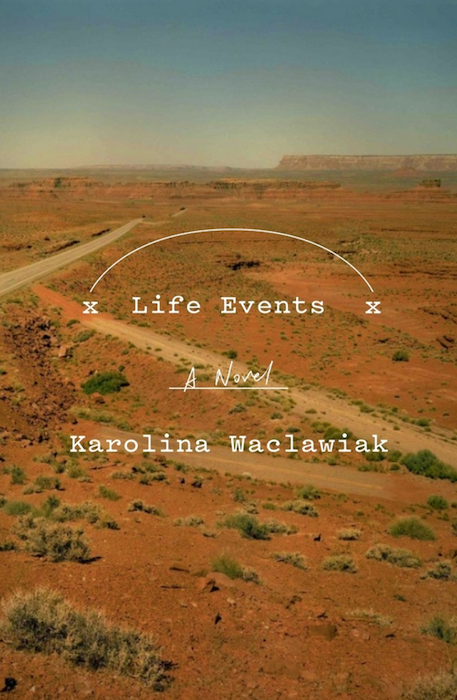
By
LIFE EVENTS
By Karolina Waclawiak
Do you know how to euthanize a bird? If not, you will just a few pages into “Life Events,” Karolina Waclawiak’s astute and distressing new novel.
Technically, euthanizing a bird isn’t that hard. All you need to do is make a concoction of simple syrup, a crushed anti-inflammatory pill and a crushed anti-anxiety pill, and administer it via an eyedropper. But as the protagonist, Evelyn, discovers, “the agony was in the waiting.” She has to sit by him for hours, watching him die after “dropping the mixture onto his tongue, hoping he would take the sip that would finally dull his pain.”
We meet Evelyn at 37, aimless, jobless, in the last stages of her dying marriage and consumed with grief over her parents’ impending death. It’s in this state that she notices a “hummingbird in distress” on the patio of her Los Angeles apartment, and resolves to put it out of its misery.
A few weeks later, Evelyn enrolls in a program for so-called death doulas, or people who come to patients’ homes to prepare them for euthanasia and be with them until the end. The narrative follows her training and then her work with three very different patients. Evelyn approaches the job with true devotion, but she fails at detachment — a requirement in this position. Evelyn is too present, too involved, too reckless — to the point of having to seek a Plan B pill after an encounter with one of the patients.
The job would’ve been unbearable if not for the alcohol and anti-anxiety pills that Evelyn takes to dull her own pain. Waclawiak accomplishes a brilliant feat here, creating an atmosphere of almost palpable, effortful dullness that presides over the entire novel. With so much opportunity for raw emotion, the author seems to avoid it at all cost, going for exceptional clarity instead.
In the absence of any real emotional attachment to the characters, the reader is forced instead to engage intellectually, to actually face the tough questions about our own inevitable death.
In the novel, the death doulas have to make sure that their patients make an informed decision rather than an emotional one; so as part of their training, they have to fill out the same questionnaires they give to their patients. In these passages the reader can’t help pausing and applying the questions to herself. One of the toughest questions asks what degree of livelihood constitutes a life worth living, on a scale from 100 percent (full health) to 0 percent (death). “By 60 percent, mobility was reduced and disease was significant,” Evelyn explains with clinical matter-of-factness. “Consciousness could waver between full, drowsy and confused.”
Imagining yourself functioning at 60 percent is scary enough, but it’s fully terrifying to think what will happen to you at 30 percent or below. An easier option would be to just keep your head in the sand and not think about death at all. And this is exactly what a majority of Americans are doing.
The health crisis we are living through has exposed many uncomfortable truths about our collective state of denial. Most people have reacted to the threat of Covid-19 as if this were the only possible cause of death, as if they’d never before fully considered their mortality. Tallying the pandemic’s daily fatalities with fanatical persistence, these individuals and public health officials are ignoring all the other deaths, praying for a vaccine that will allow them to finally relax, as if the prevention of one specific disease could render one immortal.
And even before Covid-19, our medical and cultural institutions would put so much effort into “defeating” death, which actually means prolonging life by just weeks or days at the cost of horrible suffering. Meanwhile, so little effort is put into helping patients accept their eventual death, effectively encouraging them to ignore mortality.
Waclawiak’s “Life Events” provides a powerful argument against that attitude. The novel offers you a hand, gently helping you pull your head out of the sand to accept the inevitable.
Complete Article ↪HERE↩!
